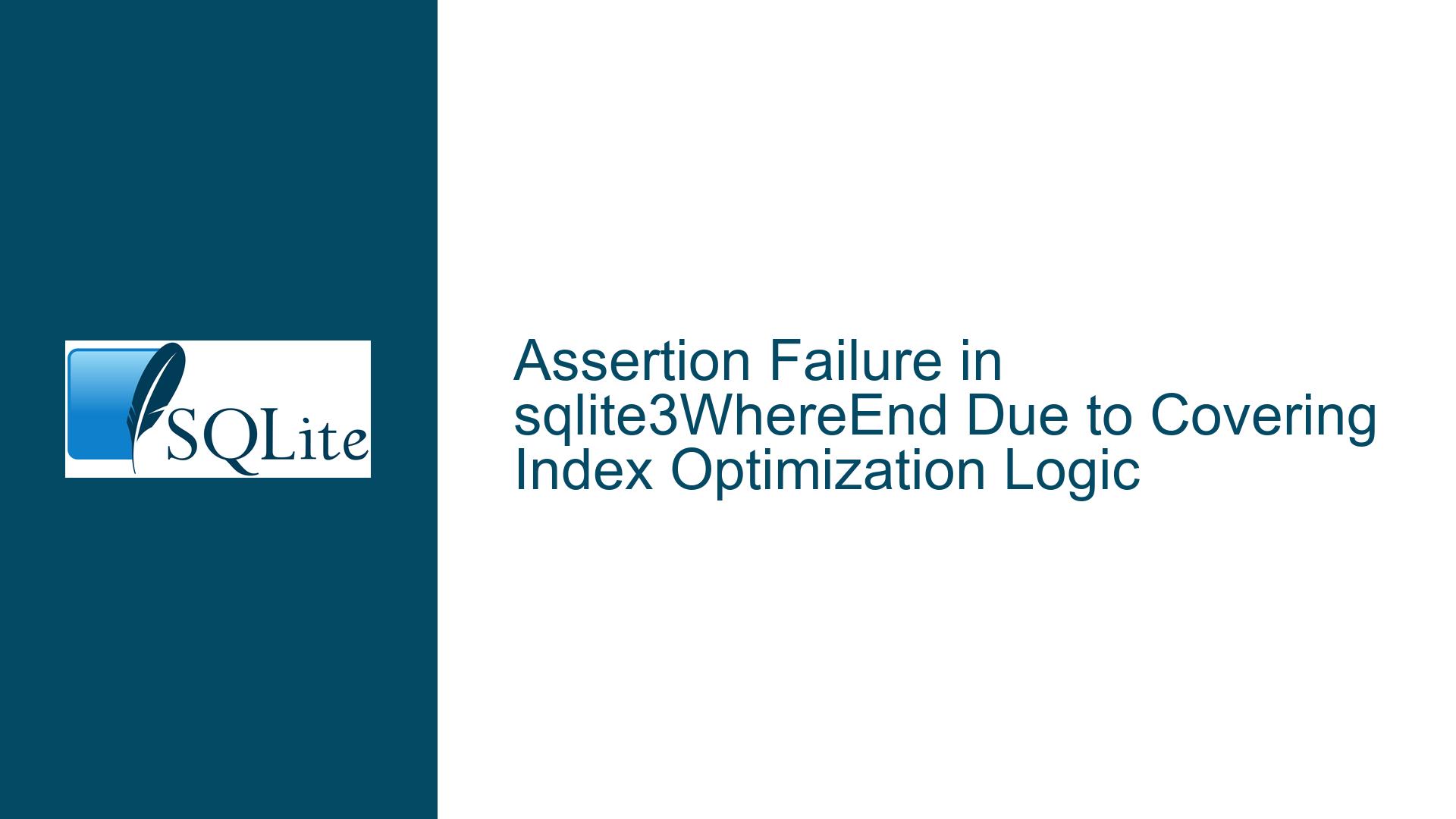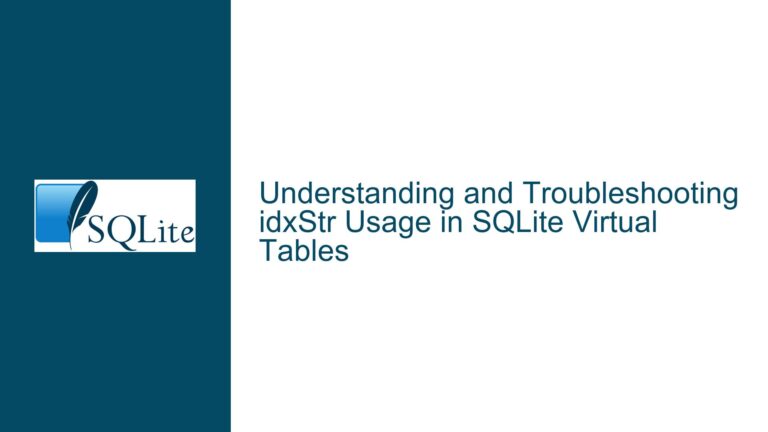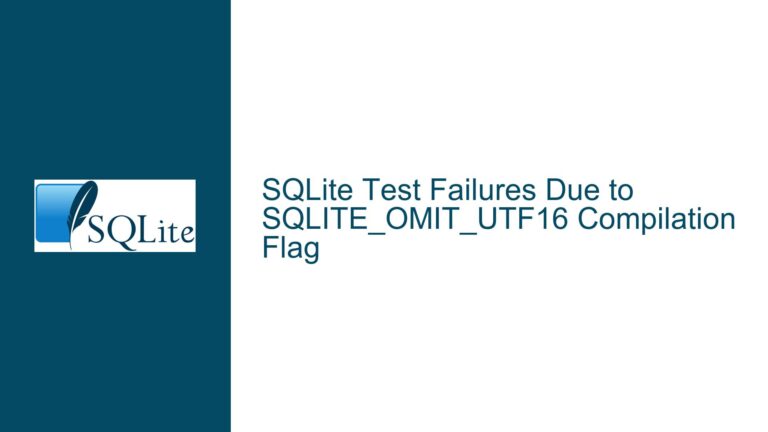Assertion Failure in sqlite3WhereEnd Due to Covering Index Optimization Logic
Issue Overview: Assertion Triggered During Table-to-Index Translation in WHERE Clause Processing
The core problem revolves around an assertion failure in the sqlite3WhereEnd function during query execution, specifically when processing a complex UPDATE statement involving views, triggers, and window functions. This occurs in debug builds compiled with --enable-debug, where SQLite’s internal sanity checks (assertions) validate assumptions about query planner logic. The assertion (pLoop->wsFlags & WHERE_IDX_ONLY)==0 || x>=0 || pOp->opcode==OP_Offset || pWInfo->eOnePass enforces expectations about when column data must be read directly from a table versus relying on index-only scans.
The failure is triggered by a specific interaction between three components:
- A view (
x) with a window function: The viewxis defined usingCOUNT(*) OVER (), which introduces a window frame computation. - An INSTEAD OF trigger (
t2a) on the view: This trigger intercepts UPDATE operations on the view and replaces them with custom logic (aSELECT 1placeholder). - An UPDATE statement with a self-join: The query
UPDATE x SET a=t1.a FROM t1 WHERE x.a=t1.aattempts to correlate the viewxwith the base tablet1.
The SQLite query planner employs the covering index optimization (WHERE_IDX_ONLY) to avoid unnecessary table lookups by using index entries directly. When translating table references to index references, the code assumes that either (a) the table cursor remains valid, (b) the OP_Offset opcode adjusts the cursor position, or (c) the one-pass optimization (eOnePass) is active. The assertion enforces these invariants. However, the combination of the view’s window function, the trigger’s interception, and the self-join confuses the planner’s logic, leading to a scenario where none of these conditions hold true.
Possible Causes: Fragile Assertion Logic in Covering Index Optimization Paths
The root cause lies in the interaction between SQLite’s query planner optimizations and the schema’s structural complexity. Specifically:
1. Misalignment Between WHERE_IDX_ONLY Flag and Cursor Validity
The WHERE_IDX_ONLY flag indicates that an index scan provides all required columns, eliminating the need to read the underlying table. However, in this case, the UPDATE statement’s join condition (x.a=t1.a) requires accessing both the view (backed by t1) and the base table t1. The planner might incorrectly assume that the index covers all necessary columns, even though the view’s window function (COUNT(*) OVER ()) introduces synthetic columns not present in the base table’s schema. This mismatch invalidates the index-only scan assumption, leaving the table cursor in an unexpected state.
2. Trigger Interference with One-Pass Optimization (eOnePass)
The INSTEAD OF trigger replaces the UPDATE operation with a custom action. SQLite’s eOnePass optimization is designed to handle simple UPDATE/DELETE operations in a single pass without materializing intermediate results. However, the presence of the trigger forces the query planner to abandon this optimization, as the trigger’s logic may require multiple passes or additional cursor operations. The assertion expects eOnePass to be active in certain scenarios, but the trigger disrupts this expectation.
3. Window Function-Induced Complexity in View Materialization
The view x includes a window function (COUNT(*) OVER ()), which materializes a synthetic column (c1). Window functions require SQLite to buffer intermediate results during execution, which can interfere with cursor positioning and index eligibility checks. When the UPDATE statement references the view, the planner must reconcile the materialized window data with the base table’s indexes. If the index used for the WHERE clause does not include the synthetic c1 column, the covering index optimization becomes invalid, yet the planner might still attempt to use it.
4. Fragile Assertion Conditions in Debug Builds
The assertion itself is overly strict. It assumes that if WHERE_IDX_ONLY is set, then either (a) the cursor offset (x) is valid, (b) the OP_Offset opcode adjusts the cursor, or (c) eOnePass is active. However, edge cases involving views, triggers, and window functions can violate these assumptions. For example, the OP_Offset opcode is not emitted when the cursor is optimized out entirely, and eOnePass is disabled due to the trigger. This leaves no valid condition to satisfy the assertion, causing a false-positive failure in debug builds.
Troubleshooting Steps, Solutions & Fixes: Resolving Assertion Failures in Complex Query Plans
Step 1: Validate Schema and Query Plan Interactions
Begin by analyzing the query plan for the UPDATE statement using EXPLAIN or EXPLAIN QUERY PLAN. Focus on whether the planner selects an index-only scan (showing USING COVERING INDEX) and whether the trigger or view materialization alters cursor usage.
EXPLAIN QUERY PLAN
UPDATE x SET a=t1.a FROM t1 WHERE x.a=t1.a;
Look for operations involving the x view and t1 table. If the plan shows a covering index scan on t1 but the view requires columns not present in the index, this indicates a misapplication of the WHERE_IDX_ONLY optimization.
Step 2: Disable Covering Index Optimization Temporarily
To confirm the role of WHERE_IDX_ONLY, force the query planner to disable index-only scans using PRAGMA optimize=0x00001 (disable covering index optimization). If the assertion no longer fails, this confirms the optimization is at fault.
Step 3: Simplify the Query Structure
Break down the UPDATE statement into smaller components to isolate the issue:
- Remove the trigger (
DROP TRIGGER t2a) and test the UPDATE. - Replace the view with a direct reference to
t1. - Remove the window function from the view definition.
If the assertion disappears after removing the trigger or window function, this identifies the component introducing the planner inconsistency.
Step 4: Patch the Assertion Logic
In SQLite’s source code, the assertion in sqlite3WhereEnd was replaced with a more robust check in later versions. For developers encountering this issue, modify the assertion to handle edge cases involving triggers and window functions. The revised logic should explicitly account for:
- Cursor invalidation due to trigger execution.
- Synthetic columns from views breaking index coverage.
Example code adjustment (from SQLite’s commit history):
/* Original problematic assertion */
assert( (pLoop->wsFlags & WHERE_IDX_ONLY)==0 || x>=0 || pOp->opcode==OP_Offset || pWInfo->eOnePass );
/* Revised logic */
if( (pLoop->wsFlags & WHERE_IDX_ONLY) && x<0 && pOp->opcode!=OP_Offset && pWInfo->eOnePass==0 ){
// Handle error or disable optimization
}
Step 5: Update to a Fixed SQLite Version
The SQLite team addressed this issue by replacing the fragile assertion with a more resilient implementation. Ensure you’re using SQLite version 3.38.0 or later, where the faulty assertion is removed.
Step 6: Avoid Anti-Patterns in Schema Design
Prevent recurrence by avoiding schema constructs that confuse the query planner:
- Window functions in updatable views: Materialized window results complicate cursor management.
- INSTEAD OF triggers on complex views: Use triggers sparingly on views with aggregations or window functions.
- Self-referential UPDATEs: Rewrite queries to use explicit joins or subqueries instead of self-joins on views.
Step 7: Monitor Query Planner Decisions
Use SQLite’s debugging interfaces (e.g., sqlite3_trace_v2) to log query planner decisions in production-like environments. This helps identify planner missteps before they cause assertion failures in debug builds.
Final Solution:
For most users, upgrading SQLite and avoiding the schema anti-patterns listed above will resolve the issue. Developers maintaining custom SQLite forks should backport the assertion fix or implement the revised logic from Step 4.






